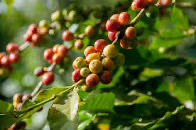 |
| Coffee Plant with Cherries |
Anybody who knows me may realise that I’ve got a thing going on for coffee. In fact, since the time that Kathy and myself met and got together, coffee has been our staple. Long gone are the days of making a pot of tea for myself alone in my flat. Although, tea was very much my mother and grandmother’s daily tipple. Both had it very strong and black with the bare minimal splash of milk!
Fast forward to today, and I, rather than the supermarket decaffeinated instant coffee, have single-origin beans that I grind myself and produce a fine dark golden liqueur from either my Aeropress or Chemex pour-over.
When I started with the Aeropress at work, it did turn a few heads. A few fellow coffee lovers know what I am doing and appreciate the smells that emanate from the kitchen. I’m always up for sharing a cup of the finest with colleagues who appreciate the fine arts of speciality coffee brewing.
With billions of cups of coffee being brewed around the world daily. Where and when did our love for coffee start?
Coffee houses first appeared in Oxford in 1651. Populated by men only and they were a place for intellectual conversations. So much so that they were coined Penny Universities. It was a penny for a cup of coffee back then.
At about the same time, coffee was starting to be imported into Italy. The earliest coffee shop in Venice is the Caffe Florian dating back to 1720. Italians don’t order milk-based coffee drinks, Cappuccinos, Cafe Lattes and others after 11 am. These milky coffee drinks are the reserve of the mornings, usually with a pastry. Should they require a caffeine hit later in the day, Italians will go for a shot of espresso, although they would simply say Caffe.
During World War 2, American soldiers in Italy found the coffee too strong. They wanted the familiar taste of the filtered, drip coffee that they got back home. Their cure for this was to add a little hot water to the local caffe, which the Italians dubbed the Americano.
There is a broader coffee culture across Europe. The world’s biggest coffee consumer, surprisingly, is Finland. The average consumption is 12kgs per person per year. Finnish workers can legally have two mandated coffee breaks a day. The average Finn drinks at least four cups a day.
 |
| Cherries - Processed Beans -Roasted |
None of these countries has their own coffee-growing industries. Coffee grows in a minimal area between the Tropics of Cancer and Capricorn, on either side of the Equator. Brazil is the world’s largest coffee producer. With nearly 2.6 million tons a year, they are followed by Vietnam. Vietnam has grown 17% of the world’s coffee. 95% is Robusta beans, with the remaining 5% devoted to arabica production.
Arabica and robusta are two of the species of beans produced for consumption. Robusta is grown at lower elevations and has a higher caffeine content than arabica. Coffea Arabica is grown at a slightly higher elevation; in both species, there can be deviations from the norm.
Robusta (Coffea canephora) is known for its harsher, stronger, and deeper flavour profile, making it more suited for instant coffee. Arabica ( Coffea Arabica), with its lower caffeine level and nuances of brighter and sweeter flavours, makes it the favourite of coffee lovers. Arabica is also more expensive than the other species, but that is well balanced with wide varieties and unforgettable flavours that coffee lovers can brew.
 |
| Water processing beans |
As I wrote earlier, I have an Aeropress and a Chemex filter pour-over that I use to brew my coffee. I have used coffee to regain some of my senses of taste and smell that I lost due to Covis-19 back in March 2020. Coupled with my Porlex Mini 2 grinder, I have learnt to brew some very flavoursome coffee. Each month I purchase a mix of single-origin beans and blends from a couple of different rosters. I have between two or three cups daily, except for having the fourth cup on an odd day. Each single-origin bean or blended bean has its subtle individuality that can be brought by being brewed perfectly.
Many factors can influence the flavour of brewed coffee. Water, heat, brewing method, grind size, and time contribute to a beautiful cup of coffee. I think I have techniques sorted for both pieces of brewing equipment that I use, although each bean or blend usually calls for a little tweak here and there to produce the very best that you can.
Brewing your coffee is not the fastest of undertakings. Apart from grinding the beans, it usually takes three minutes to brew from my Aeropress and five minutes from my Chemex. These are slow coffee experiences and are more akin to a ritual. I feel that it has been good for my well-being and mindfulness. The slow coffee experience is gaining ground in cafes. I know a few in Exeter and South Devon; to sit and savour a well-balanced and nuanced cup of coffee whilst writing a few hundred words on my MacBook Air has got to be up there with one of the best things ever.
That is a bit of an insight into the research I have done for an article pitch on coffee. The subject is just huge, and there are many angles to write. There should be some milage in this research with a few feature pieces to be written.
© Photographs - copyright to original owners
No comments:
Post a Comment